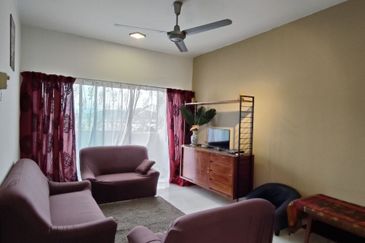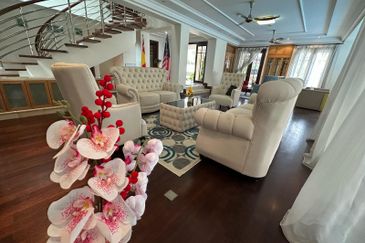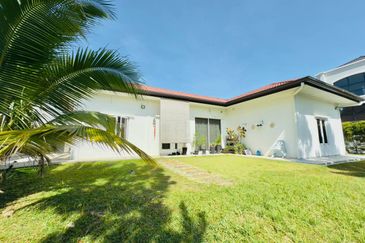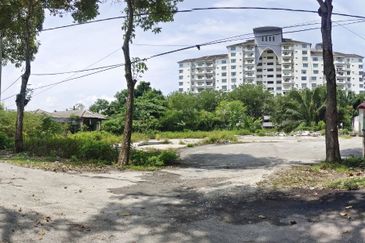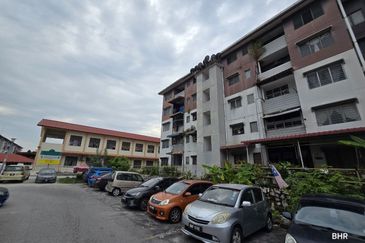PENANG-BORN Datuk Albert Moh’s ambition growing up was to be an architect. However, after graduating from Tunku Abdul Rahman University College in 1986 with a Diploma in Building, he started his career as a marketing executive in Hunza-Land Corp Bhd (now known as Hunza Properties Bhd).
“Although I was employed as a marketing executive, I had multiple tasks. I had different roles from marketing and contract administration to site evaluation. I was also the assistant to the general manager,” Moh, founder and managing director of M Summit Group, tells City & Country.
“I picked up a lot of experience in property development from Hunza-Land. Later, with this experience, I managed to lead the whole development team in Penas Group which, at that point in time, was an up-and-coming developer, although it is no longer in operation now.”
Penas Group developed a number of landmarks in Penang, such as Island Hospital and Prangin Mall.
Moh left the industry in 1997, just before the Asian financial crisis, but returned in 1998 when he was encouraged by a few partners to build a 27-storey apartment with 261 units, dubbed GL Garden, in Paya Terubong, Penang.
That piqued his interest in property development and led him to establish his own company, Ideal Summit Group, in 2000. The group changed its name to M Summit Group in 2005.
The company’s first project was the Zoo Road residential development in Air Itam. It comprised 11 two-storey terraced houses and was completed in 2002.
“At the time, we sold at a higher price compared with similar developments in the area because we were offering bigger land areas of 20ft by 80ft and 20ft by 85ft, while other terraced houses in the area were 20ft by 40ft or 20ft by 45ft. The selling price of 2-storey terraced houses then was below RM300,000, but I sold our terraced houses for RM350,000 while the corner lot was priced at RM580,000,” says Moh.
Since then, M Summit has continued to build boutique landed residential developments — semi-detached homes, bungalows and terraced houses.
To date, it has completed 15 projects in Penang with a total gross development value (GDV) of RM120 million.
The company completed the freehold D’Pavilion in Batu Maung in January this year. Comprising six bungalows and four semidees, the 0.6-acre development has a GDV of RM12 million and only three units are unsold. The units have built-ups of 3,892 to 5,870 sq ft. The price of the semidees ranges from RM1.95 million to RM1.98 million while the bungalows are priced at RM2.8 million.

Answering the call for more affordable homes
While the group is continuing with boutique projects, it has also ventured into the affordable, low-cost and low-medium-cost home segments with Ramah Pavilion and Taman Ria in Teluk Kumbar, work on which started last year. The two freehold projects sit next to each other.
Moh was inspired by the state government’s efforts to encourage more local developers to build affordable homes.
“We attended a talk on affordable homes by Jagdeep Singh Deo, Penang state exco for housing and town and country planning, in August 2013. Jagdeep called on all developers in Penang to help the state government build affordable homes. As you know, there was a general election in the same year and one of the main topics was affordable homes as properties were becoming more expensive.
“After the talk, I was inspired to help the state government and decided to be in this [affordable housing] segment for a few years. I thought it was time to give back to the community after having been in property development for 20 years. The site for Ramah Pavilion was originally planned for 3-storey semidees,” he says.
The 3.8-acre project is M Summit’s first high-rise residential development. It will comprise two towers — 36 and 39 storeys — with a total of 759 units. There are six layouts, with built-ups of 800 to 1,355 sq ft. The selling price ranges from RM198,000 to RM398,000. Each unit will come with a parking bay and homeowners have the option of purchasing additional parking lots for RM30,000 each.
Despite being affordably priced, Ramah Pavilion will offer condominium facilities such as a swimming pool and wading pool that comes with a water slide, sun deck, playground, gymnasium, study and reading room, and barbecue and sand pit.
It will also have 24-hour security and a CCTV monitoring network with a security card access system.
In support of the state government’s efforts to promote green activities, Ramah Pavilion will have a rooftop farming deck where residents can plant vegetables, fruits and other fresh produce. “We figured that those who bought the units would be young families and their parents may stay with them. The parents would have retired, so we’re giving them an activity to do,” says Moh.
According to him, plans for Ramah Pavilion were submitted in 2013 and the project received development approval last year.
“When I submitted my plans, the state government hadn’t come out with guidelines for affordable homes yet, so I submitted the plans without the guidelines,” says Moh. “It was only after our plan for Ramah Pavilion was approved that the state government came out with the guidelines for size and selling prices, where a RM200,000 house should have a built-up of 750 sq ft, RM300,000 should be 850 sq ft and RM400,000, 900 sq ft.”
Ramah Pavilion was launched in January and it was officiated by Jagdeep. About 30% of the units have been sold. Interested buyers of another 20% of the units are on the waiting list, and the developer has sent their forms to the state government for approval.
“An intended buyer has to fill in the PN1 Form (application form) from the state housing department (SHD), and attach it with all the required documents. Our office staff will assist them and once everything is in order, we will forward the application form and documents to SHD for the necessary vetting.
“SHD will then compile a list of successful applicants and submit it to the Selection Process Enhancement Committee chaired by Jagdeep for approval before giving us the approved list,” says Moh.
As Ramah Pavilion is part of the state government’s initiative, the group cannot sell the units on its own. “It has to go through the state government’s process,” Moh explains.
The 1.8-acre Taman Ria will comprise three 17-storey blocks of 135 low-cost and 135 low-medium-cost apartments. The built-up of the low-cost units is 634 sq ft and they are priced at RM40,000 while the 665 sq ft low-medium-cost units are priced at RM65,000.
Both Ramah Pavilion and Taman Ria are due for completion in 2018.
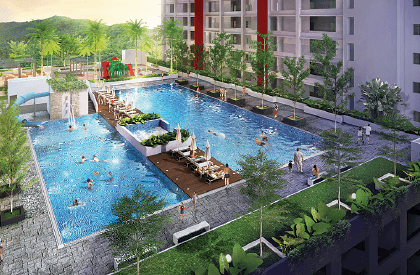
Making affordable and low-cost homes work
The scheme for low-cost and low-medium-cost homes has been in place since the 1980s. During the time, it was difficult to acquire a unit as the formalisation of the procedure took a long time, Moh says.
However, he notes that many are still unaware of the scheme and the projects.
“To help the state government and the community, we have our marketing representatives approach companies, factories and people in the street about Ramah Pavilion and educate them about the affordable scheme on behalf of the state government,” he says. “While some know of the scheme, they don’t know how and where to apply.”
According to Moh, the affordable home guidelines also set out the unit price for each income bracket. Those in the income bracket of below RM10,000 are eligible to purchase units priced below RM400,000. Units priced below RM300,000 are for those who earn below RM8,000 while units priced at RM200,000 are for those earning below RM6,000.
“Only first-time homebuyers qualify for the scheme,” Moh says. “As for financing, if they cannot qualify on, say, a combined husband-and-wife income, they can rope in their parents or siblings to be joint borrowers but not joint purchasers. We have very few cases of rejections. Maybe less than 2% of the buyers have asked for refunds of the down payment, which we willingly do in full, except they have to pay some nominal legal charges if they have signed the sales and purchase agreement.”
When asked how M Summit manages its costs when building affordable houses, Moh credits his wife, Jennifer Ong, who is the purchasing director.
“Ramah Pavilion and Taman Ria are different from the other projects that we have done. For these developments, we work within the budget allocated by the finance department and try to work with the suppliers to get the materials at a reasonable price.
“My wife is very good at negotiating, so she gets a good price for the materials for these affordable and low-cost to low-medium-cost developments.”
Moh himself made personal calls to the suppliers, convincing them to assist the company in building Ramah Pavilion and Taman Ria. “I called them before Chinese New Year and explained the projects to them and about contributing to the community. Many of them actually agreed, so we’re glad that these projects are coming along for the sole purpose of helping the community.”
Encouraging affordable home schemes
Michael Geh, director of Raine & Horne International Zaki + Partners, supports the federal and Penang governments’ call for more affordable housing.
“I think it’s good that the Penang government is advocating affordable homes, especially now that Jagdeep has called on the Penang developers to help the community,” he says.
“During the Penang Property Fair three years ago, homebuyers were disappointed that [they could not afford the products]. I saw couples walking out of the fair because they saw mostly products that cost millions of ringgit.”
He notes that residential properties in Penang that were launched in the last three years were mostly priced above RM500,000.
To buy a unit in the affordable schemes, certain guidelines are imposed on the buyers — for example, the homeowner cannot sell the house within 10 years, says Geh.
“In the past few years, the Penang property market has been strong for a few reasons. One is that it has been a speculator-based market. There are certain developers who sell half of their units to speculators, then offer the other half to genuine homebuyers.
“I think it is a very good effort by a private developer to come up with products such as Ramah Pavilion. I think there should be a ‘Ramah Pavilion’ everywhere in Penang, not just in Teluk Kumbar. I see more affordable home sales in the next six months.
“The state government has been approving many affordable schemes and these will be sold in the coming quarters.”
There are rumours that some parties are sceptical of the state government’s affordable home scheme, says Geh.
“I think this is a good scheme because 60% of the Penang market is in an income bracket of less than RM3,000 per household. It’s very clear that they can only afford a certain range. Products like Ramah Pavilion and some others that are coming into the market will help these people own a home,” he adds.

Future projects
M Summit has a lot on its plate with Ramah Pavilion and Taman Ria, but Moh isn’t resting on his laurels. The company is planning to develop its first commercial project — a 23-storey office building in Jalan Magazine, George Town, opposite Jen Hotel.
Dubbed Summit 191, the tower will have 96 fully furnished offices. According to Moh, the company will occupy three levels, from Levels 21 to 23. The built-ups will be from 485 to 612 sq ft but the selling price is still being finalised.
“We have received approvals from Majlis Bandaraya Pulau Pinang, allowing us to refurbish five of the existing 2-storey shophouses [in front of the office building]. The cost of the refurbishment is budgeted at RM1.25 million,” says Moh.
He anticipates building more affordable homes such as Ramah Pavilion in the next five years and is looking for opportunities outside Penang.
“I want to build affordable houses for the locals. Similar to Ramah Pavilion, we will try to offer larger units compared with similar projects. This, I believe, will be our selling point for future high-rise residences.”
Moh says when plans for Ramah Pavilion were approved, he was approached by parties from Melaka and a few other states to build similar developments.
But he is careful when choosing his projects. “With the Penang government, it’s simple to work with the development as the guidelines and working systems are transparent. When I was approached, I requested the respective parties to allow me to understand how the system works, so that I can determine the feasibility of the developments.
“If the risks are too high, we worry that the project may be abandoned.”
As for the Penang property market, Moh believes prices on the island will rise due to scarcity of land, although it will not be in the double-digit range seen a few years ago.
This article first appeared in City & Country, The Edge Malaysia, on May 25 - 31, 2015.
TOP PICKS BY EDGEPROP

Garden City Homes, Seremban 2
Seremban, Negeri Sembilan

Bandar Warisan Puteri
Seremban, Negeri Sembilan

Taman Desa Saujana Langat
Hulu Langat, Selangor



